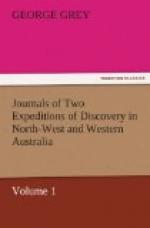On this beach (of Vansittart Bay) we found a broken earthen pot, which decidedly proved the fact of the Malays visiting this part of the coast, and explained the mischievous disposition of the natives.
...
I saw but three men of this fair race myself, and thought they closely resembled Malays; some of my men observed a fourth.
NATIVES AT ROEBUCK BAY.
An individual differing in appearance and colour from his aboriginal associates was also seen amongst a native tribe whilst the boats of the Beagle were surveying in Roebuck Bay, and is thus ably described by Mr. Usberne, the master of the vessel; who was in command of the boat at the time he was observed, and who thus narrates the interview:*
(Footnote. Nautical Magazine for 1840 page 576.)
To prevent interruption during dinner the things were removed to the boat, and she was then shoved a few yards off the beach, and we commenced our repast.
As we took to the water they (the natives) rose and followed us close; but in the act of shoving off, the boat-hook being pointed over the bow, they one and all involuntarily stepped back a couple of paces, thinking no doubt that it was one of our spears, which to them must have appeared a formidable weapon; but, seeing no harm was intended, they remained at the water’s edge, watching us whilst at dinner.
At this time I had a good opportunity of examining them. They were about the middle age, about five feet six inches to five feet nine in height, broad shoulders, with large heads and overhanging brows; but it was not remarked that any of their teeth were wanting (as we afterwards observed in others); their legs were long and very slight, and their only covering a bit of grass suspended round the loins. There was an exception in the youngest, who appeared of an entirely different race: his skin was a copper colour, whilst the others were black; his head was not so large, and more rounded; the overhanging brow was lost; the shoulders more of a European turn, and the body and legs much better proportioned; in fact he might be considered a well-made man at our standard of figure. They were each armed with one, and some with two, spears, and pieces of stick about eight feet long and pointed at both ends. It was used after the manner of the Pacific Islanders, and the throwing-stick so much in use by the natives of the south did not appear known to them.
After talking loud, and using very extravagant gestures, without any of our party replying, the youngest threw a stone, which fell close to the boat.
...
COINCIDENCE OF CUSTOMS.
It appears to me very probable that the same dark-coloured race inhabit the whole of Northern Australia, and perhaps extend over the islands in Torres Strait.
In order to support this opinion I shall first give an extract from the journal of Dr. Duncan, from Wilson’s Voyage round the World, page 148, which contains a detail of the customs of Flinders Islands and part of Northern Australia, and displays two or three remarkable customs coinciding with those observed by myself and others to exist in Northwest Australia:




